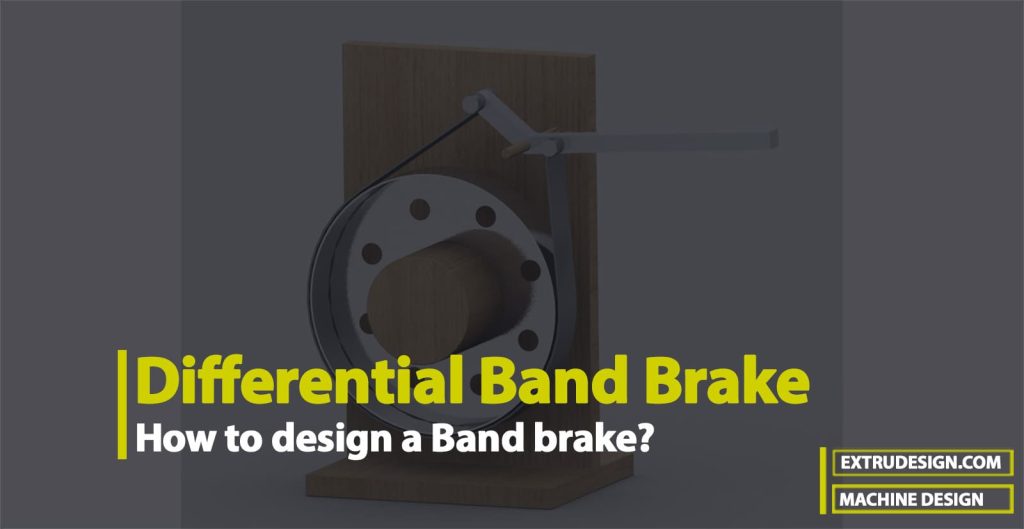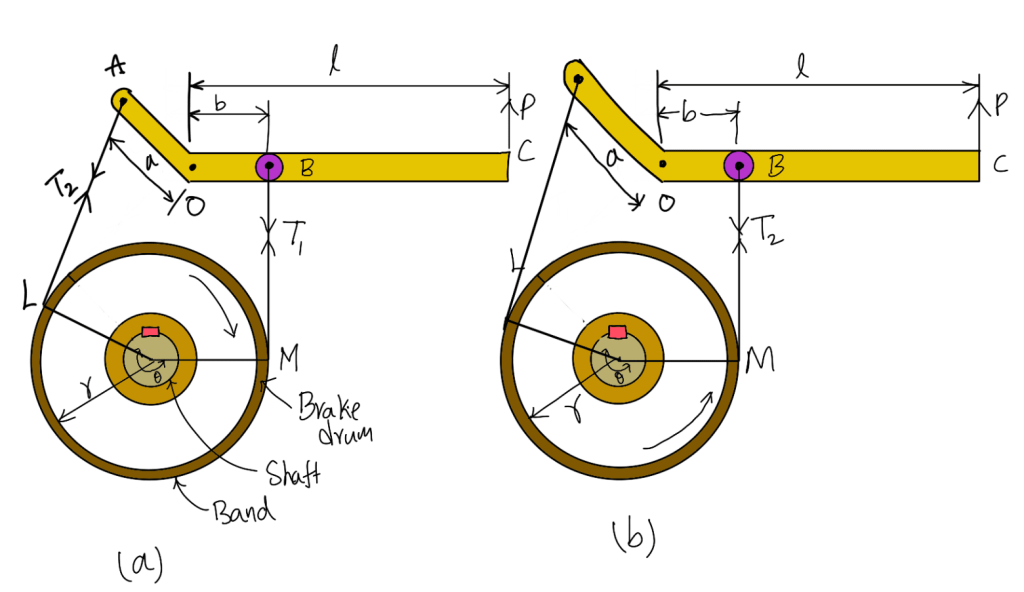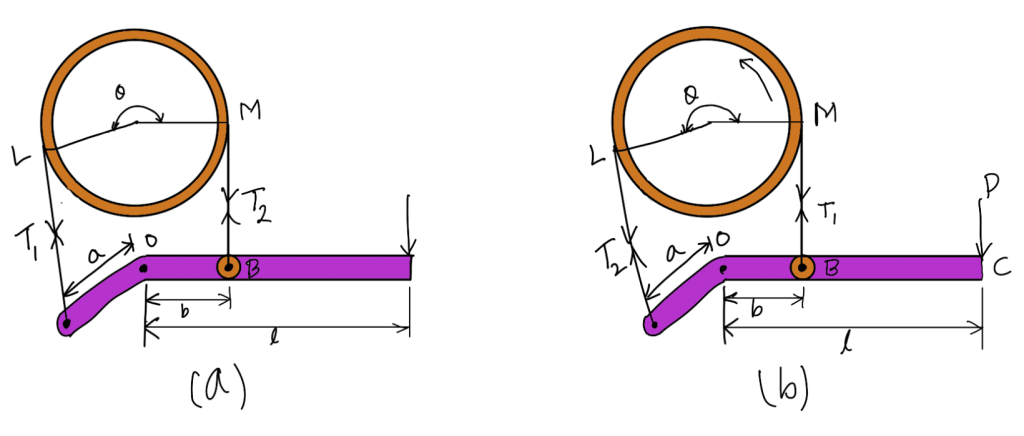A brake is a device by means of which artificial frictional resistance is applied to a moving machine member, in order to retard or stop the motion of a machine. In the process of performing this function, the brake absorbs either the kinetic energy of the moving member or potential energy given up by objects being lowered by hoists, elevators, etc. In the previous articles, we discussed how we can calculate the energy absorbed by a brake and Heat Dissipation during Braking. We also discussed the different types of Brakes in the previous article. Let us discuss the Differential Band Brake in detail.

As we mentioned above that the brake is used to retard or stop the motion of a machine. This action is called Braking. In the process of braking, the brake absorbs either the kinetic energy of the moving member or potential energy given up by objects being lowered by hoists, elevators, etc. The energy absorbed by brakes is dissipated in the form of heat. This heat is dissipated in the surrounding air (or water which is circulated through the passages in the brake drum) so that excessive heating of the brake lining does not take place.
The design or capacity of a brake depends upon the following factors:
- The unit pressure between the braking surfaces
- The coefficient of friction between the braking surfaces
- The peripheral velocity of the brake drum
- The projected area of the friction surfaces
- The ability of the brake to dissipate heat is equivalent to the energy being absorbed.
The major functional difference between a clutch and a brake is that a clutch is used to keep the driving and driven member moving together, whereas brakes are used to stop a moving member or to control its speed.
We also solved an example problem to stop A vehicle of mass 1200 kg moving down the hill at a slope of 1:5. by finding how much amount of Braking Torque is required to stop the vehicle in the previous article.
Differential Band Brake
A band brake consists of a flexible band of leather, one or more ropes, or steel lined with friction material, which embraces a part of the circumference of the drum. A simple band brake in which one end of the band is attached to a fixed pin or fulcrum of the lever while the other end is attached to the lever at a distance b from the fulcrum. In a differential band brake, as shown in the following figure, the ends of the band are joined at A and B to a lever AOC pivoted on a fixed pin or fulcrum O. It may be noted that for the band to tighten, the length OA must be greater than the length OB.

(a) Clockwise Rotation of Drum (b) Anticlockwise Rotation of Drum
The braking torque on the drum may be obtained in a similar way as discussed in simple band brake. Now considering the equilibrium of the lever AOC. It may be noted that when the drum rotates in the clockwise direction, as shown in the above figure (a), the end of the band attached to A will be slack with tension T2 and end of the band attached to B will be tight with tension T1. On the other hand, when the drum rotates in the anticlockwise direction, as shown in the above figure (b), the end of the band attached to A will be tight with tension T1 and end of the band attached to B will be slack with tension T2. Now taking moments about the fulcrum O, we have
P.l + T1.b = T2.a
P.l = T2.a – T1.b
…(for clockwise rotation of the drum)
…… Equation (1)
P.l + T2.b = T1.a
P.l = T1.a – T2.b
…(for anticlockwise rotation of the drum)
….Equation (2)
We have discussed block brakes in the previous article, when the frictional force helps to apply the brake, it is said to be the self-energizing brake. In the case of differential band brake, we see from equations (1) and (2) that the moment T1.b and T2.b helps in applying the brake (because it adds to the moment P.l) for the clockwise and anticlockwise rotation of the drum respectively.
We have also discussed that when the force P is negative or zero, then the brake is self-locking. Thus for differential band brake and clockwise rotation of the drum, the condition for self-locking is
T2.a ≤ T1.b
T2/T1 ≤ b / a
and for anticlockwise rotation of the drum, the condition for self-locking is
T1.a ≤ T2.b
T1/T2 ≤ b / a
👉Important Notes:
1. The condition for self-locking may also be written as follows. For the clockwise rotation of the drum,
T1.b ≥ T2.a
T1/T2 ≥ a/b
and for anticlockwise rotation of the drum,
T2.b ≥ T1.a
T2/T1 ≥ a/b
2. When in the above schematic figures (a) and (b), the length OB is greater than OA, then the force P must act in the upward direction in order to apply the brake. The tensions in the band, i.e. T1 and T2 will remain unchanged.
3. Sometimes, the band brake is attached to the lever as shown in the following figures (a) and (b). In such cases, when OA is greater than OB, the force (P) must act upwards. When the drum rotates in the clockwise direction, the end of the band attached to A will be tight with tension T1 and the end of the band attached to B will be slack with tension T2, as shown in the following figure (a). When the drum rotates in the anticlockwise direction, the end of the band attached to A will be slack with tension T2 and the end of the band attached to B will be tight with tension T1, as shown in the following figure (b).

(a) Clockwise Rotation of Drum (b) Anticlockwise Rotation of Drum
4. When in the above figures (a) and (b), the length OB is greater than OA, then the force (P) must act downward to apply the brake. The position of tensions T1 and T2 will remain unchanged.
For brakes of hand-operated winches, steel bands of the following sizes are usually used:
| Width of band (w) in mm | 25 – 40 | 40 – 60 | 80 | 100 | 140 – 200 |
| Thickness of band (t) in mm | 3 | 3 – 4 | 4 – 6 | 4 – 7 | 6 – 10 |

Leave a Reply